Cranky Owlet has no words…
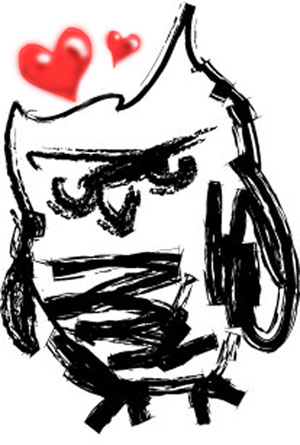
…to describe his devotion to vole
(for lunch)

In Phoenix there are cardinals.
Everybody knows the football Cardinals, aka “the Redbirds”, who nearly won the Superbowl recently. But fewer people, even native Arizonans, know that we also have real Northern cardinals, (Cardinalis cardinalis), aka cardenal comun. You can’t imagine how surprised some people are when they find out the familiar peaky-headed, conical-billed redster lives in the desert. I can’t explain this, except that so many folks who live here are originally from the leafy Midwest and Eastern US where the bird is an iconic resident of yards, gardens, and woodlands. The classic Redbird is so common in the East that it’s the state bird of no fewer than seven states: Illinois, Indiana, Kentucky, North Carolina, Ohio, Virginia and West Virginia, more than any other bird (just edging out the Western meadowlark with six and the Mockingbird with five). But the spiny, dry desert? Nope: in many people’s minds, the cardinal doesn’t figure in this land of Cactus wrens, buzzards, and roadrunners. Without going off on a much of a rant (see “PS” below for a short one), I blame popular culture — especially cartoons — which are such a pervasive influence on what we “know” about the world around us that they can override actual observation.
For example, this is a typical conversation: Friend: Hey, what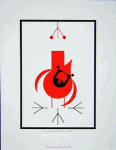 kind of a bird did I see at the Desert Botanical Garden yesterday? It looked exactly like a cardinal, but I know it couldn’t be, because they don’t live here! Me: Was it all red with a black mask and a point on its head, a little smaller than a robin? (We don’t frequently see robins here, but it’s a meaningful comparison for most non-birders because everyone knows robins). Friend: Yes. Me: Then it was a cardinal. Friend: What do they do, stock them there or something? etc…
kind of a bird did I see at the Desert Botanical Garden yesterday? It looked exactly like a cardinal, but I know it couldn’t be, because they don’t live here! Me: Was it all red with a black mask and a point on its head, a little smaller than a robin? (We don’t frequently see robins here, but it’s a meaningful comparison for most non-birders because everyone knows robins). Friend: Yes. Me: Then it was a cardinal. Friend: What do they do, stock them there or something? etc…
But cardinals do live here, and they are more or less native. 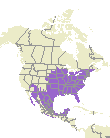 By that I mean according to the Cornell Lab of Ornithology whose range map this is, Northern cardinals were “first sighted” in south-central Arizona in the 1870s. (Were they here already, and some white guy just noticed them and told some official ornithology guy back east? I don’t know.) But their range is expanding northward, and now they’re found along the Colorado River, among other western locations, and there are even insular populations in Los Angeles and Honolulu, although somebody put them there, they didn’t wing themselves over. Our desert cardinals like desert scrub and riparian areas, especially if there is water convenient. They are found in some neighborhoods in Phoenix, but not all. We see them occasionally in our yard, but the only evidence I’ve personally seen of breeding sadly involved a female cardinal feeding a cowbird chick.
By that I mean according to the Cornell Lab of Ornithology whose range map this is, Northern cardinals were “first sighted” in south-central Arizona in the 1870s. (Were they here already, and some white guy just noticed them and told some official ornithology guy back east? I don’t know.) But their range is expanding northward, and now they’re found along the Colorado River, among other western locations, and there are even insular populations in Los Angeles and Honolulu, although somebody put them there, they didn’t wing themselves over. Our desert cardinals like desert scrub and riparian areas, especially if there is water convenient. They are found in some neighborhoods in Phoenix, but not all. We see them occasionally in our yard, but the only evidence I’ve personally seen of breeding sadly involved a female cardinal feeding a cowbird chick.
Nothing looks redder than a male cardinal against greenery, and the cardinals of the Sonoran desert are no exception; in fact, they may look even redder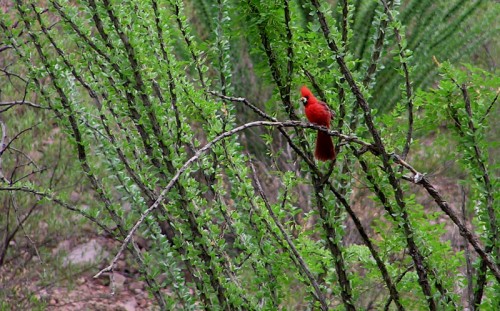 . There could be a couple of reasons for this. Our subspecies, Cardenalis cardenalis superbus is the largest of the subspecies, and its crest isn’t significantly less red than its breast, and its black facial mask is slightly less extensive than that in other subspecies. All of this adds up to More Redder. Above is a picture of a Cardinal in front of a fully leafed-out Ocotillo. He has a grub in its beak which he flew away with, which means he was feeding young or a female at the nest. Otherwise he would have gulped it down himself.
. There could be a couple of reasons for this. Our subspecies, Cardenalis cardenalis superbus is the largest of the subspecies, and its crest isn’t significantly less red than its breast, and its black facial mask is slightly less extensive than that in other subspecies. All of this adds up to More Redder. Above is a picture of a Cardinal in front of a fully leafed-out Ocotillo. He has a grub in its beak which he flew away with, which means he was feeding young or a female at the nest. Otherwise he would have gulped it down himself.
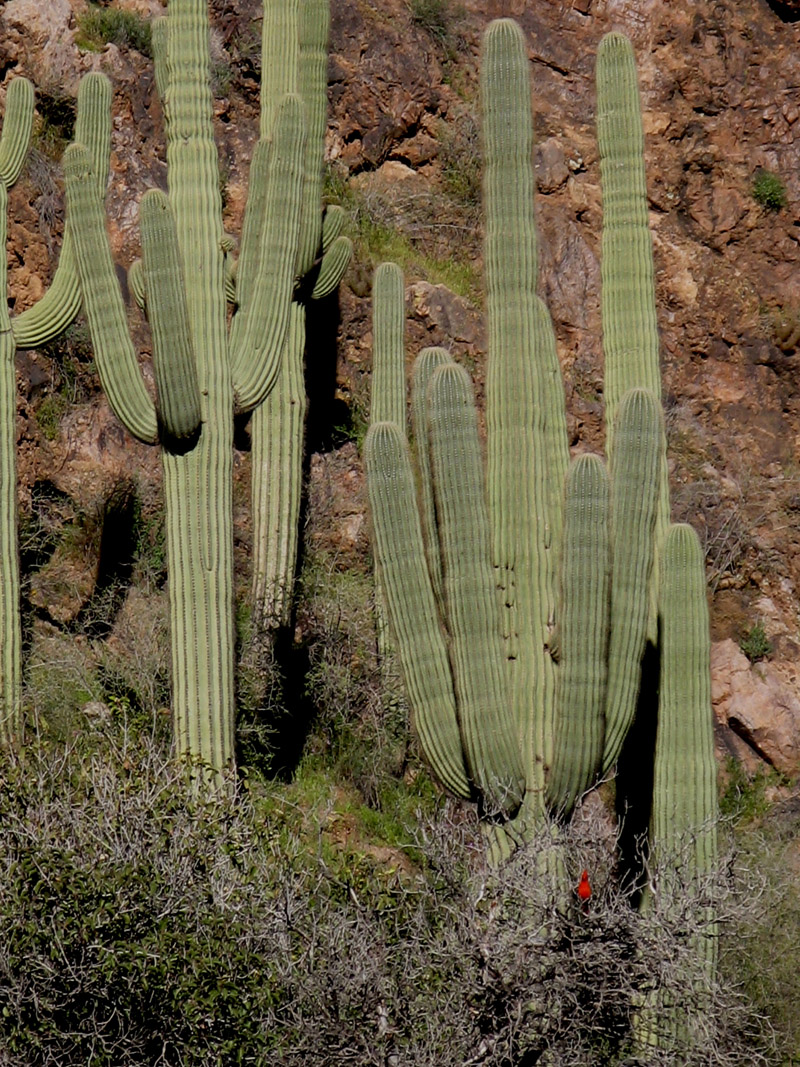 So, in the interest in promoting the broader image of cardinals in all of our minds, the photo to the left is a replacement iconography to “cardinal in the snow”: a male cardinal in the Sonoran Desert. This one, along with about six others heard or seen within a half-mile of the trailhead, was singing out his nuptial qualifications loud and clear on the Peralta Trail in the Superstition Mountains east of Phoenix last March. Feel free to click on the photo to see a larger image.
So, in the interest in promoting the broader image of cardinals in all of our minds, the photo to the left is a replacement iconography to “cardinal in the snow”: a male cardinal in the Sonoran Desert. This one, along with about six others heard or seen within a half-mile of the trailhead, was singing out his nuptial qualifications loud and clear on the Peralta Trail in the Superstition Mountains east of Phoenix last March. Feel free to click on the photo to see a larger image.
Photos: #1, male Northern cardinal at Boyce Thompson Arboretum, Superior, AZ (A. Shock). #2, male Northern cardinal and Ocotillo, Rancho Esmeralda, Sonora, Mexico (A. Shock). #3, male Northern cardinal and saguaros, Superstition Mtns, Pinal County, AZ (A. Shock).
Rant warning (this makes me see red). The prevalent and imaginary species “yellow-billed cardinal” has been a pet-peeve of mine since we lived in St. Louis. Both the baseball Cardinals and the football Cardinals (who were still in St. Louis when we were) use jazzy redbird logos that show Cardinals with yellow bills. The baseball Cardinals’ mascot, Fredbird, has a yellow bill, too. The artist in me understands that the second spot of color makes for livelier graphics.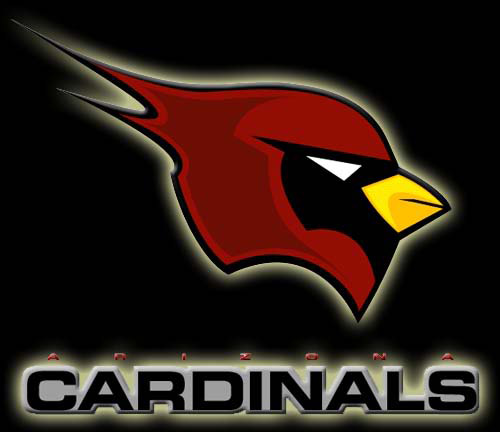 Unfortunately, I think it’s also another example of pop culture infesting our knowledge of the real world: robins have yellow bills, duckies have yellow bills, therefore cartoon crows have yellow bills, and therefore all bird’s bills are yellow. And it’s not just the two Cardinals teams — start looking at images of birds in advertising and popular graphics: most birds have yellow bills. Having made the complaint, I’m not saying sports logos should all be biological illustration (although the Baltimore Oriole is pretty realistic). But for me the redbird logo loses some “cardinal-ness” with the bill color inaccuracy — it is shifted away from cardinal and toward generic bird, which is less interesting. But I empathize with an artist who has to make a cardinal look tough, and I do admire the result, from a graphics point of view. Here’s the Arizona Cardinals logo, and I have no idea if I’m infringing on copyright to post it here; I hope not.
Unfortunately, I think it’s also another example of pop culture infesting our knowledge of the real world: robins have yellow bills, duckies have yellow bills, therefore cartoon crows have yellow bills, and therefore all bird’s bills are yellow. And it’s not just the two Cardinals teams — start looking at images of birds in advertising and popular graphics: most birds have yellow bills. Having made the complaint, I’m not saying sports logos should all be biological illustration (although the Baltimore Oriole is pretty realistic). But for me the redbird logo loses some “cardinal-ness” with the bill color inaccuracy — it is shifted away from cardinal and toward generic bird, which is less interesting. But I empathize with an artist who has to make a cardinal look tough, and I do admire the result, from a graphics point of view. Here’s the Arizona Cardinals logo, and I have no idea if I’m infringing on copyright to post it here; I hope not.
However, I don’t think there’s any hope of biological integrity for Fredbird. Sorry. I have never seen a Cardinal with yellow gloves on. And what’s with the primary-colored primaries? A real cardinal isn’t colorful enough? It’s just not right…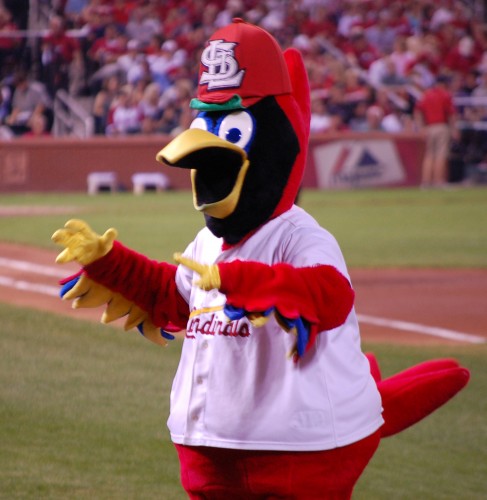
Now, if you want to see a real desert-dwelling cardinal-like bird with a yellow bill, check out the fabulous Pyrrhuloxia at an excellent post from Firefly Forest, which I can’t improve on. Except to add, here’s a Pyrrhuloxia portrait magnet, from 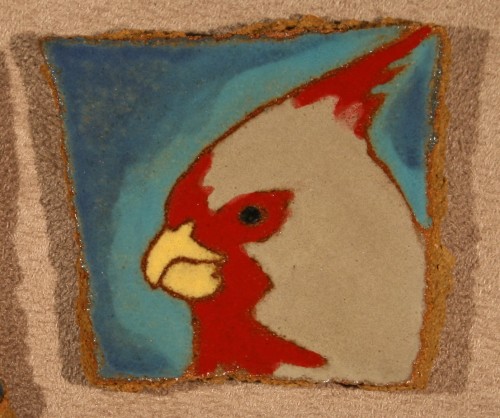 Three Star Owl:
Three Star Owl:
 Allison does not consider herself a wildlife artist,
but an observer who takes notes in clay.
More info...
Allison does not consider herself a wildlife artist,
but an observer who takes notes in clay.
More info...

(for lunch)
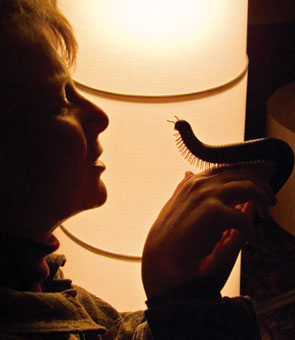 Tuesday night E and I heard a biomimicry expert speak at ASU. Her name is Janine Benyus, and she’s a natural history author who’s been documenting the emerging cross-disciplinary field of biomimicry. Before hearing her talk, I had a very primitive notion of biomimicry: “Dude, did you know a spider’s silk is 10 times stronger than steel — like, if we could do that, how cool would it be?” And, like most over-simplified notions, it’s both right and not so much.
Tuesday night E and I heard a biomimicry expert speak at ASU. Her name is Janine Benyus, and she’s a natural history author who’s been documenting the emerging cross-disciplinary field of biomimicry. Before hearing her talk, I had a very primitive notion of biomimicry: “Dude, did you know a spider’s silk is 10 times stronger than steel — like, if we could do that, how cool would it be?” And, like most over-simplified notions, it’s both right and not so much.
Here is the Wikipedia definition of biomimicry: Biomimicry (from bios, meaning life, and mimesis, meaning [imitation]) is a relatively new science that studies nature, its models, systems, processes and elements and then imitates or takes creative inspiration from them to solve human problems sustainably.
Benyus’s presentation was an overview of some of the work being done RIGHT NOW on deriving high-tech solutions to problems in engineering, health, agriculture, energy production and many other fields by observing organisms and natural systems. Her idea: “We need to re-design everything”, as she admits is a tall order, but from her examples, there are a lot of smart people working on it 24/7. Here are some of the things she mentioned:
 by bone-mimicking software (check it out on this link)
by bone-mimicking software (check it out on this link)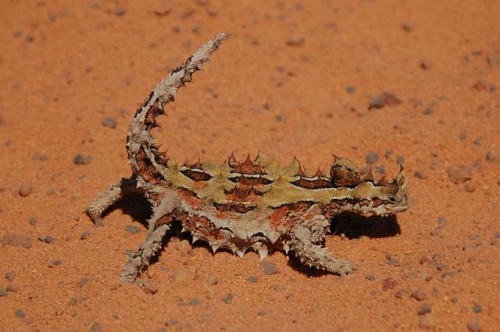
These are only a small fraction of the projects she covered. There’s more at the website Asknature.org, which is designed not only to introduce the public to the concept of biomimicry, but has a resource section for connecting people with nature-based strategies for the problems they need to solve: “sticking to”, “self-cleaning”, “break down,” etc.
What struck me most (apart from the really smart ideas biomimicry people are coming up with) were two things: 1) Biomimicry is a fantastic example of why Basic Research is important and should be funded. The ideas involved are not vague tree-hugging notions of how we should all “learn from the animals”, but fact-based high-tech products, companies, projects, and enterprises created by biologists, engineers, entrepreneurs, designers, scientists and 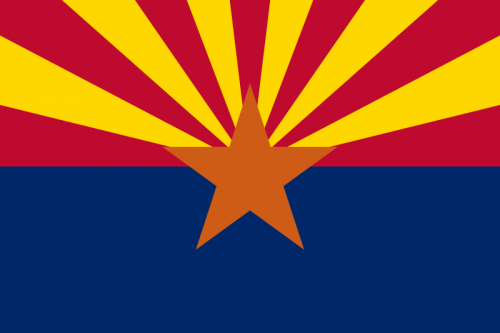 others working together: commerce and science, business and academia tightly and productively intertwined. And they arise from basic research: many are launched from studies that are undertaken to further our knowlegde of the world around us, and not originally intended to result in commercial applications. And 2) The Arizona angle. Not only did Benyus point out how the desert itself is full of organisms surviving under adverse conditions and so is a perfect system to study and learn from, but also how many people in biomimicry are working at Arizona State University. Over and over, she mentioned names of scientists, teachers, and students who were sitting around us in the audience. While this made me proud of ASU, it was painful too in light of the ongoing budget crisis created by partisan factions in the Arizona state legislature. Even as we sat there listening to all the social, economic, scientific, and environmental advances ASU personnel are making in schools and departments from Design to Chemistry, money was being ripped away short-sightedly from those very programs and people in the name of fiscal responsibility.
others working together: commerce and science, business and academia tightly and productively intertwined. And they arise from basic research: many are launched from studies that are undertaken to further our knowlegde of the world around us, and not originally intended to result in commercial applications. And 2) The Arizona angle. Not only did Benyus point out how the desert itself is full of organisms surviving under adverse conditions and so is a perfect system to study and learn from, but also how many people in biomimicry are working at Arizona State University. Over and over, she mentioned names of scientists, teachers, and students who were sitting around us in the audience. While this made me proud of ASU, it was painful too in light of the ongoing budget crisis created by partisan factions in the Arizona state legislature. Even as we sat there listening to all the social, economic, scientific, and environmental advances ASU personnel are making in schools and departments from Design to Chemistry, money was being ripped away short-sightedly from those very programs and people in the name of fiscal responsibility.
Bad bad bad monkeys — what are the politicians thinking? “Monkey see monkey do” — biomimicry and its educational foundations and commercial development — deserves staunch support, for the good of the future. And Arizona, with its universities already deeply involved in such research, could be a leader in biomimicry studies and industry. But only with a well-nourished educational system. As Benyus said, the defiinition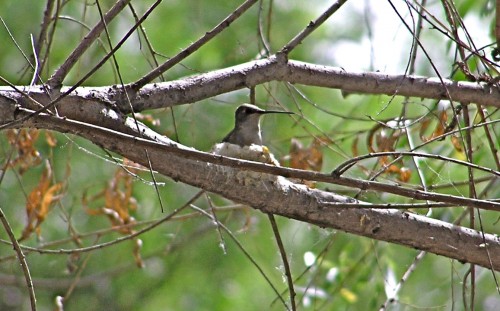 of the success of a species is not whether its offspring survive, but whether its 10-thousandth generation survives. To do that, a species must take care of where its offspring will live. This is what a bird does when it builds a nest, this is what nature does on both a grand and a small scale: “Life creates conditions conducive to life.” That is the lesson for individuals, for people in charge of policy and states: it is the lesson for the ages.
of the success of a species is not whether its offspring survive, but whether its 10-thousandth generation survives. To do that, a species must take care of where its offspring will live. This is what a bird does when it builds a nest, this is what nature does on both a grand and a small scale: “Life creates conditions conducive to life.” That is the lesson for individuals, for people in charge of policy and states: it is the lesson for the ages.
But in the interest of happy thoughts, I’ll leave you with this final fact, humorous visual image, and new word: Supposedly, the “stiction” of a fully engaged gecko could support 200 pounds. Imaging suspending a porky politician — by his waist of course — from the ceiling, with a just a gecko! How sustainable is that?
Photos: I’m uncertain whom to credit the great photo of Ms. Benyus and a very large milipede to. But in case this applies, I will credit AskNature.org, a project of The Biomimicry Institute. The photo of the Thorny Devil is from Wikipedia, and is by Wouter. The female hummer is a Black-chinned girl on a nest built above a footpath at the Nature Conservancy’s Hassayampa Preserve near Wickenburg, AZ, by A. Shock.
Internet emailing list services — “listserves” — are an excellent way for birders to spread the word about what’s being seen in the area, and useful information about how to get there, which tree it was sitting in last, and which landowners show up with cookies and which with a shotgun. But a birder cannot live by list-serve alone. Sometimes I forget this, or get too wrapped up in the “art birds” in the studio, and not the real birds that are out there which inspire them.
So Sunday, though it was very wet at times because of a robust late winter storm that’s bringing snow to Arizona’s peaks and rain to its deserts (=wildflowers!!!), E and I went to view Da Boids at the Salt River east of the east end of Tempe Town Lake, otherwise known as “Tempe Marsh”. We went with friends who get out more than we do, which was a good thing because there was a surprise there I wouldn’t have given a second look at without a knowledgeable nudge in the ribs.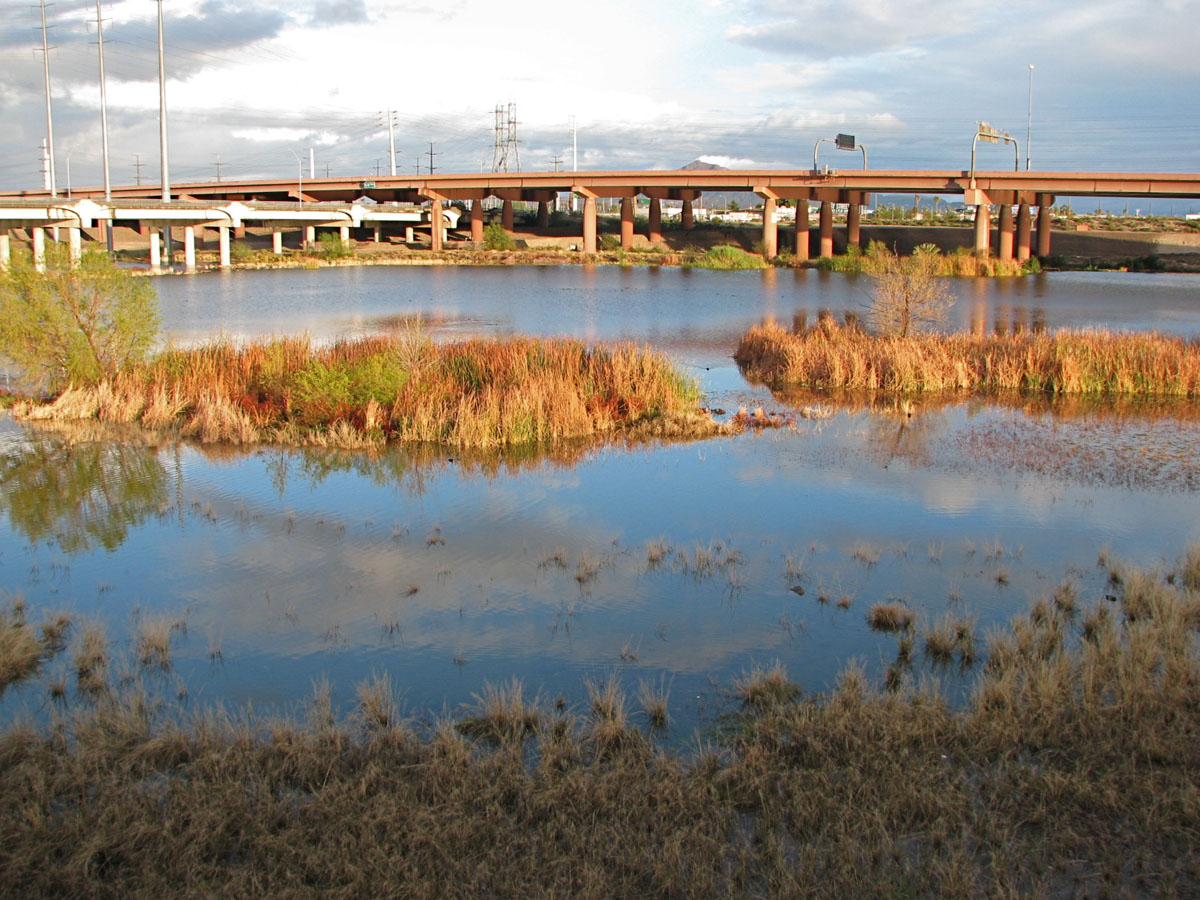
For those who aren’t familiar with it, Tempe Town Lake is a stretch of the Rio Salado (or Salt River, the jugular of Phoenix) on the northern edge of the city of Tempe, just east of Phoenix and south of Scottsdale. In the late 1990’s, engineers took the unusual action of damming the Salt at two places with huge black inflatable rubber tubes stretched from bank to bank. (The fall of the river is so flat here, that putting in just a downstream dam wouldn’t create usable depth.) The dams take advantage of a “gaining” stretch of the Rio Salado. At this point underground river water is naturally forced to the surface by bedrock (ASU’s A-Mountain and other visibly hard features jutting up out of the flatlands) and the dam slows this water and pools it together with added recycled water. The combination of human engineering and natural geology enable what on the surface often appears to be a feeble desert river to create a body of water significant enough to allow the public to fish, boat, scull, and reflect on the unappealing commercial buildings the City of Tempe has blighted A-Mountain with. If you remember the area from earlier days, it’s quite a change to the scenery to drive by downtown Tempe on the elevated Loop 202 freeway and see its bridges and buildings reflected in sun-catching wavelets.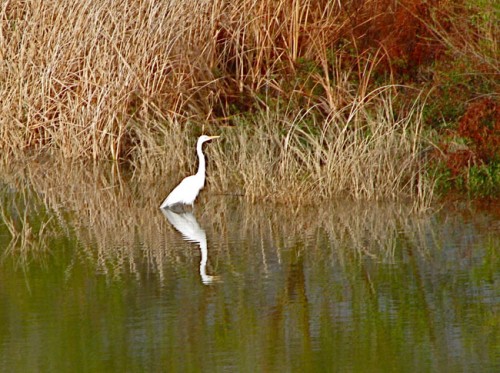
One of the activities enhanced by this sudden advent of standing water is birding. Or, to be less anthropocentric, the new lake created habitat which has attracted a good number of waterbirds, waders, and shorebirds, as well as raptors and some landbirds (in the willows and cottonwoods that seem to spring up nearly overnight). All these in turn have attracted birders.
It’s drive-up birding, and definitely not pastoral. It isn’t quite as gritty as birding the landfill or most sewage lagoons, but it’s not wilderness. It’s very….suburban. With the sun at your back you stand at the edge of the parking lot for the mega retail complex called Tempe Market Place (hereafter TMP). It’s necessary to block out the piped-in pop music drifting across the asphalt from the shops, and to try to ignore the inviting odors of grilling carne asada telling you that your breakfast was only oatmeal, and really early in the morning. On an afternoon visit, you may vie for parking with movie-goers, and Fridays are the worst — the scene includes local bands playing at “the District”, the “lifestyle” part of the outdoors retail vortex. The most obvious features of the landscape, though, are the roads: the Mill Avenue bridges, placed at the historic Rio Salado ford and Hayden Ferry crossing (for many years the only crossing on the Salt in Phoenix), and the the raised causeway portion of the Loop 202, the Red Mountain Expressway, looming over everything. The sound of traffic is sometimes hard to hear birds over. And bring a scope, because most of the birds are at a distance.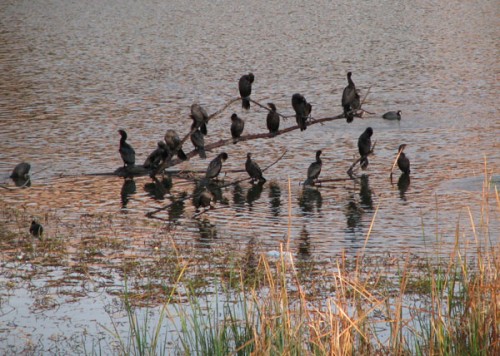
But there are birds to see. Double-crested and a few Olivaceous cormorants are everywhere: flying in and away in skeins, hung out to dry in drowned snags (photo right), swimming with just head and neck exposed. An Osprey cruises by, then a Red tailed hawk, and a Belted kingfisher barrels thorugh, rattling. There are sandpipers, and killdeer, and coots and their more colorful cousins, Common moorhens; red-winged blackbirds and grackles; grebes of two species; egrets and herons; a group of Rough-winged swallows passing through. And there are ducks: Gadwall and Mallards, tons of Shovellers, and teal. 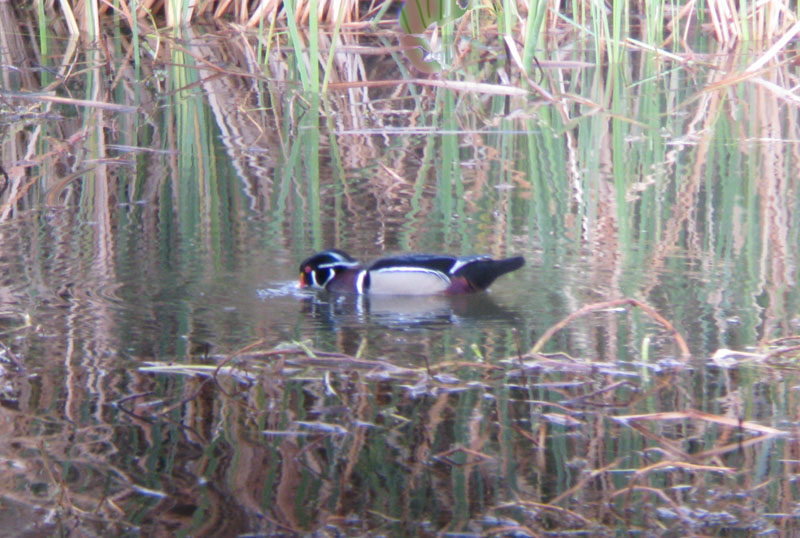 This morning a pair of ornately plumaged drake Wood ducks (one seen in photo left) are floating together in and out of the cattails, looking exotic although they are not uncommon in the winter here, and breed elsewhere in the state.
This morning a pair of ornately plumaged drake Wood ducks (one seen in photo left) are floating together in and out of the cattails, looking exotic although they are not uncommon in the winter here, and breed elsewhere in the state.
What keeps birders coming here, though, are the occasional surprises. Sunday’s surprise (at least, to me — the others were looking for it since it’s been observed in this location at least since January) was a long-distance visitor hanging with the local Green winged teal: a Common or Eurasian teal, Anas crecca. This is a bird that should be in Japan in winter, or in Turkey, not Tempe. Remember Bugs Bunny’s “I shoulda toined left in Albuquoykee?” These things sometimes happen with migratory species; they get blown around, or take a wrong turn. But I was glad our friends were on top of things, and pointed out the different field marks, because they’re subtle enough so that at a distance I easily skipped over them.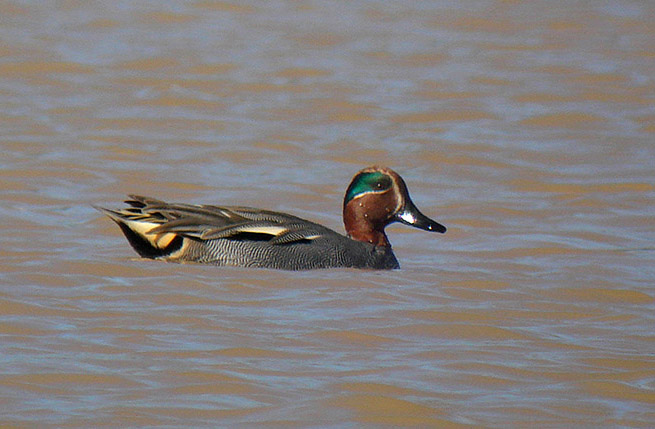 Our bird was too distant to photo, so to the right is a photo by Michael Moore of an individual seen last year at the Gilbert Water Ranch, not too far from Tempe Marsh. Since a picture’s worth 1K words, I’ve also included below a photo by ASU prof Pierre Deviche of a local Green-winged teal for you to compare: note the prominent vertical breast bar on the side of the local teal, and the more prominent white head lines on the Common teal.
Our bird was too distant to photo, so to the right is a photo by Michael Moore of an individual seen last year at the Gilbert Water Ranch, not too far from Tempe Marsh. Since a picture’s worth 1K words, I’ve also included below a photo by ASU prof Pierre Deviche of a local Green-winged teal for you to compare: note the prominent vertical breast bar on the side of the local teal, and the more prominent white head lines on the Common teal.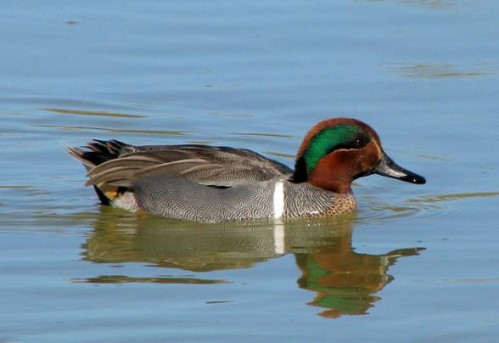
For you sticklers for accuracy, I should note that although I’ve called this a “life bird” sighting for me, technically it isn’t: the two birds, our local Green-winged teal and the Common teal, are currently considered by American authorities to be sub-species of the same species, Anas crecca. But the taxonomists may be about to split them, so I hear, and I’ll be ready!
Until then, I’ll just have to be inspired by seeing the two together, and add Green-winged teal to my “list” of birds-I-make-art-from, which is low on ducks at the moment. Because who can resist that cinnamon-and-green noggin?
Photos: Top, Tempe Marsh and the Loop 202, by E. Shock. #2: Great egret in the cattails, Tempe Marsh, E. Shock. #3, Cormorants drying, Tempe Marsh, by E. Shock. #4, Wood duck drake in cattails, Tempe Marsh, A. Shock. #5: Common teal at Gilbert Water Ranch, by Michael Moore. #6, Green-winged teal at Gilbert Water Ranch, by Pierre Deviche.
Another reason I’ve had vultures on the brain is because I owe a friend a vulture. Specifically, a king vulture, Sarcoramphus papa, the largest of the Cathartids, the New World Vultures. They are the largest vulture in our hemisphere if you don’t count the two condors, and they are striking birds (literally — I was given a hammery-beaky once-over by one in captivity long ago, but that’s a different post), with black-and-white plumage and a bare-skinned, froot-loops colored head roped with chicken-skin folds. If that weren’t enough, both genders sport a caruncle on the top of their bills: a warty, fleshy, bright orangey-yellow knob whose purpose, frankly, I don’t know, if not to gild the lily.
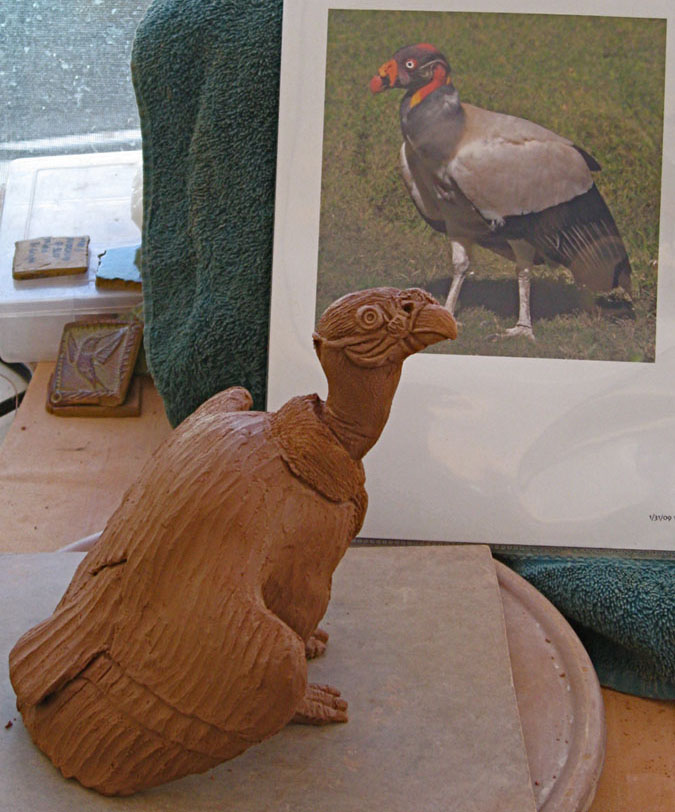 So, here is Jack’s King vulture, in progress, Increment 1. Having modeled the bird, it awaits slip, with a photo behind for plumage color reference. I’ll give it a base coat of slip (“paint” made of clay, mineral colorants, and water) in appropriate colors while the stoneware is still damp. Once it is completely dry, it will go into its first (or bisque) firing. After that it’ll get glazes and other finishing colorants applied, and be fired again.
So, here is Jack’s King vulture, in progress, Increment 1. Having modeled the bird, it awaits slip, with a photo behind for plumage color reference. I’ll give it a base coat of slip (“paint” made of clay, mineral colorants, and water) in appropriate colors while the stoneware is still damp. Once it is completely dry, it will go into its first (or bisque) firing. After that it’ll get glazes and other finishing colorants applied, and be fired again.
As usual with clay, the heaviness of the material requires support, so I’ve had to fudge some physical realities: I can’t make the legs as thin as they are in nature, and I’ve used the wings as the third point of support so the bird stands by itself. Normally, a vulture’s wings, as ample as they are, don’t reach the ground in a standing bird. But other typical characteristics will carry the likeness through: the hunched posture, the partially opened wings, the body plumage color, and of course, pleated froot-loop head.
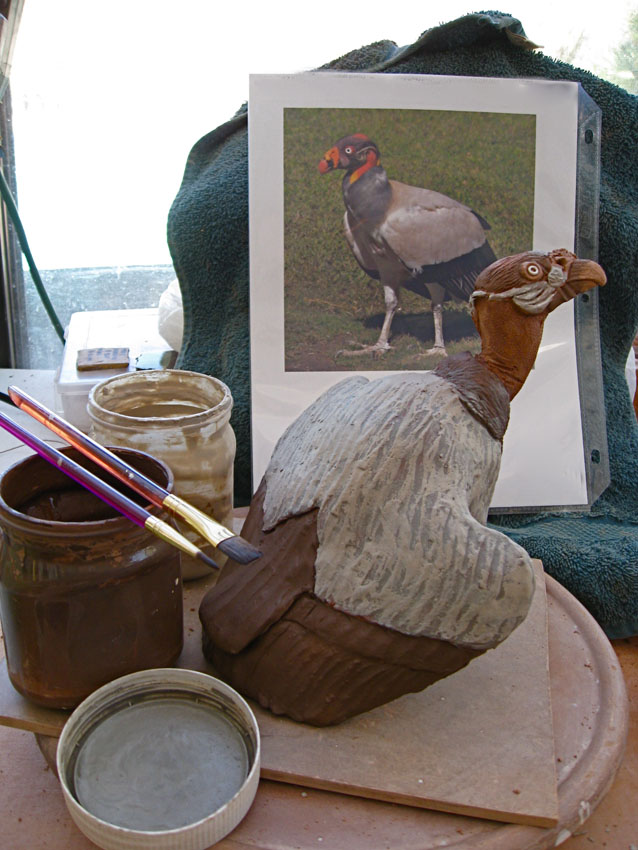 Increment 2: Slip treatment. In this case, the slips were applied with a brush. They will not acheive their finished colors until the final Cone 5 firing. For now, the black looks brown and the white looks grayish. The froot loop colors will be applied as glazes, after bisquing. Now this guy will sit until he’s TOTALLY dry. Also, his body is hollow, and this time I did remember to pierce an inconspicuous hole to the cavity. Stay tuned for later posts for finishing touches.
Increment 2: Slip treatment. In this case, the slips were applied with a brush. They will not acheive their finished colors until the final Cone 5 firing. For now, the black looks brown and the white looks grayish. The froot loop colors will be applied as glazes, after bisquing. Now this guy will sit until he’s TOTALLY dry. Also, his body is hollow, and this time I did remember to pierce an inconspicuous hole to the cavity. Stay tuned for later posts for finishing touches.
Most of us think of vultures as being all-dark birds, like Turkey vultures. But there are predominantly white vultures, like the King. In the Old World, the Egyptian vulture, also a vulture primarily of hot climates, is mostly white-plumaged. You would think a large white bird would be disadvantaged by being easily seen. Actually, King vultures, when roosting and nesting in their tropical forest habitat, are surprisingly difficult to see. Their white feathers reflect the green light passing through the foliage around them, making them blend in quite well. They are somewhat shy despite their regal reputation, and tend to assume a self-effacing posture when perched on a limb. A King vulture in Belize “hid” from us this way. We spotted it on the ground in a field. Feeling our “eyeball pressure” it felt safer flying up into a tree, where it hid its head behind a tiny clump of foliage. The rest of its enormous body remained in plain sight, but it felt better, and would peek out from the leaves occasionally to see if we were gone yet.
In the air, an all-white bird glints in the sun, but of course, up there, they’re out of reach, especially at the altitudes King vultures acheive. It’s a spectacular sight to see the bright wedge of a King, as white and as large as a pelican, rising on thermals over a mahogany forest. The photo below is of just such a Belizean forest as a King vulture would favor. Imagine one soaring just out of frame, with Bat falcons, Swallow-tailed kites, White hawks and other tropical birds of prey swirling on the updrafts from the Escarpment near Chan Chich, one of the few places in that flat country where you can get out and up over the forest.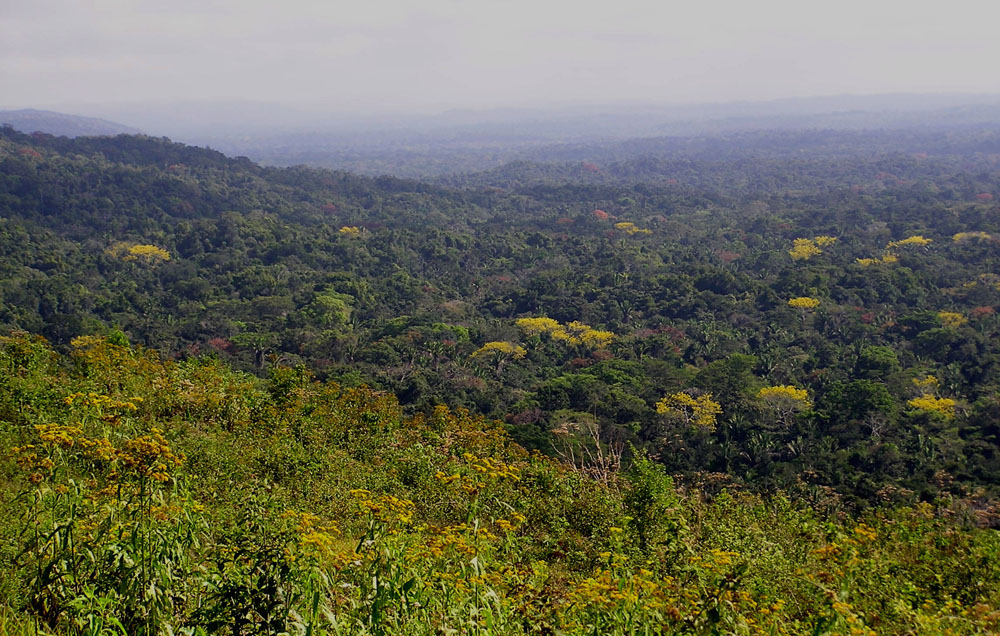
An excellent feature of Turkey vultures is see-through nostrils. That is, they lack a septum, so the opening to their sinuses goes straight through the top of their beak. This is handy for an organism which eats its meals 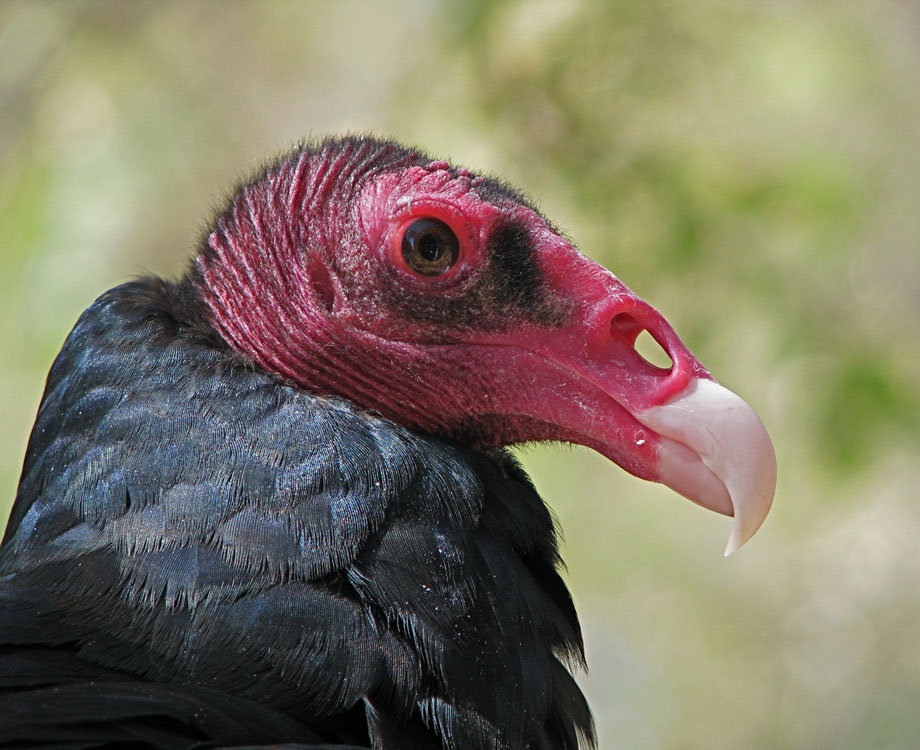 with its head in the liquescent innards of dead things. With just a quick sneeze, any annoying clogging matter can be ejected. Also, the free passage of air into the sinuses enables the scent of lunch to be picked up even from an altitude of several hundred feet.
with its head in the liquescent innards of dead things. With just a quick sneeze, any annoying clogging matter can be ejected. Also, the free passage of air into the sinuses enables the scent of lunch to be picked up even from an altitude of several hundred feet.
The pervious nostril can be easily seen in the photo above (by E. Shock). If this vulture were chilly it would keep warm by pulling his feathery neck-ruff up to his ears by corrugating his forehead skin even more.
The “pervious nostril” is a characteristic of the New World Vultures (the Cathartids: Turkey, Black, and King vultures, the Lesser and Greater Yellow-headed vultures, and both California and Andean condors) and like their bare facial skin is a physical characteristic most likely related to their ancestry: genetic studies have shown they are possibly more closely related to storks than to the Old World vultures and other birds of prey.
I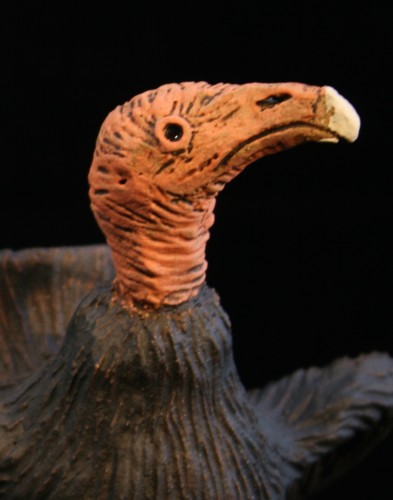 t goes without saying that the pervious nostril, as being indispensable to the visual character of the organism, is always faithfully reproduced in Three Star Owl vulture items such as candle-holders (seen to the right, as well as in the Three Star Owl Shop) and a small vulture bottle.
t goes without saying that the pervious nostril, as being indispensable to the visual character of the organism, is always faithfully reproduced in Three Star Owl vulture items such as candle-holders (seen to the right, as well as in the Three Star Owl Shop) and a small vulture bottle.
Etymology: If you grew up calling Turkey vultures “buzzards” as many Americans do, you are using a word translplanted here by European English-speaking settlers. There are no vultures in the British Isles, but there are hawks, which are called “buzzards”. When newly arrived Europeans saw our big vultures circling overhead, they used the word they had always used for raptors. The “Turkey” part of the common name “turkey vulture” comes from the fact that at a distance turkey vultures, which like wild turkeys spend a lot of time on the ground, look like turkeys, being of a similar size, with dark body plumage and having colorful bare heads.
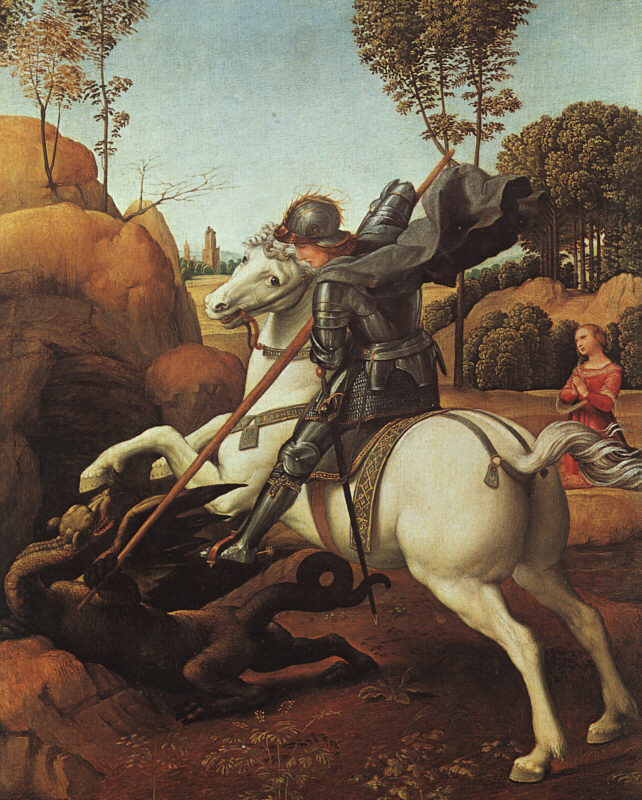 Here’s St. George killing a dragon (which in this case is admittedly a very mammalian-looking scourge). Note the size of the creature. Most St.George dragon-slayer paintings show a dragon smaller than a horse, in the vicinity of a cave and peaks in the wilderness, not a giant dinosaurian Smaug-type scale-meister.
Here’s St. George killing a dragon (which in this case is admittedly a very mammalian-looking scourge). Note the size of the creature. Most St.George dragon-slayer paintings show a dragon smaller than a horse, in the vicinity of a cave and peaks in the wilderness, not a giant dinosaurian Smaug-type scale-meister.
This observation is added to the arguments of the last post as meta-evidence of the vulture as dragon-source. Also, it’s an excuse to post this fine painting by Raphael which has been a favorite of mine since childhood.
The allegory of St. George and the dragon is a Christian re-telling of the Perseus legend, which is no doubt a re-telling of an even older tale, wherein a young hero saves the people of the country-side as well as a king’s daughter from an evil plague in the form of a dragon. For an odd version of this tale, identical in its iconography to the Raphael but almost Dali-esque in lay-out, check out Paolo Uccello’s St. George (ca. 1470):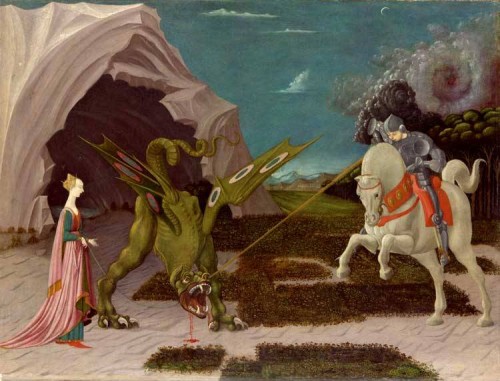
The lady does not seem to need rescuing; she appears to be walking the two-legged monster on a leash. I would put this very Jabberwocky-like anatomical configuration — two taloned legs and two wings — forward as a bird-like model for a dragon. But using art as evidence can lead to problems: look at the colorful round patterns on the bat-like wings. I do not propose that dragons and butterflies are generally considered related. And what’s with the squares of turf, and bubbly spiral rising from the trees? I’d say Uccello needed to get out more, except that there was obviously a lot of interesting stuff going on in his head… By the way, “Uccello”, a nickname, came from the painter’s fondness of painting birds, and means “bird” in Italian (and, like “cock” has another meaning, according to online sources).
Click on either painting for a larger image.
The Uccello painting, which is in London’s National Gallery, inspired the U.A. Fanthorpe poem “Not my best side”. It has nothing at all to do with vultures, but it made me laugh that such an iconic religious allegorical painting gave rise to such secular speculation — a perfect illustration of how art inspires without regard for artists’ intentions:
I
Not my best side, I’m afraid.
The artist didn’t give me a chance to
Pose properly, and as you can see,
Poor chap, he had this obsession with
Triangles, so he left off two of my
Feet. I didn’t comment at the time
(What, after all, are two feet
To a monster?) but afterwards
I was sorry for the bad publicity.
Why, I said to myself, should my conqueror
Be so ostentatiously beardless, and ride
A horse with a deformed neck and square hoofs?
Why should my victim be so
Unattractive as to be inedible,
And why should she have me literally
On a string? I don’t mind dying
Ritually, since I always rise again,
But I should have liked a little more blood
To show they were taking me seriously.II
It’s hard for a girl to be sure if
She wants to be rescued. I mean, I quite
Took to the dragon. It’s nice to be
Liked, if you know what I mean. He was
So nicely physical, with his claws
And lovely green skin, and that sexy tail,
And the way he looked at me,
He made me feel he was all ready to
Eat me. And any girl enjoys that.
So when this boy turned up, wearing machinery,
On a really dangerous horse, to be honest
I didn’t much fancy him. I mean,
What was he like underneath the hardware?
He might have acne, blackheads or even
Bad breath for all I could tell, but the dragon–
Well, you could see all his equipment
At a glance. Still, what could I do?
The dragon got himself beaten by the boy,
And a girl’s got to think of her future.III
I have diplomas in Dragon
Management and Virgin Reclamation.
My horse is the latest model, with
Automatic transmission and built-in
Obsolescence. My spear is custom-built,
And my prototype armour
Still on the secret list. You can’t
Do better than me at the moment.
I’m qualified and equipped to the
Eyebrow. So why be difficult?
Don’t you want to be killed and/or rescued
In the most contemporary way? Don’t
You want to carry out the roles
That sociology and myth have designed for you?
Don’t you realize that, by being choosy,
You are endangering job prospects
In the spear- and horse-building industries?
What, in any case, does it matter what
You want? You’re in my way.–U.A. Fanthorpe
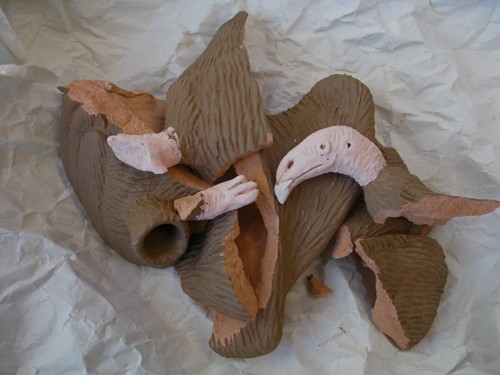 A vulture blew up in a bisque kiln yesterday. Dang! And it was my own fault, too, a foolish, neophyte error: its body was hollow, and I forgot to make a hole in it for the hot air inside to escape, kerPOW. The carnage is visible, right. Fortunately, nothing else in the kiln was harmed.
A vulture blew up in a bisque kiln yesterday. Dang! And it was my own fault, too, a foolish, neophyte error: its body was hollow, and I forgot to make a hole in it for the hot air inside to escape, kerPOW. The carnage is visible, right. Fortunately, nothing else in the kiln was harmed.
Vultures have been on my mind recently. Not only because I’ve been making turkey vulture items like the candle-holder that blew up, and the small “bottle” with the movable head in a recent post, but because of a show I watched recently on PBS.
It wasn’t about vultures. It was called the Dragon Chronicles, and it was an episode of Nature with a genial herpetologist traveling around the other hemisphere finding examples of real reptilian organisms which shared some of the characteristics of dragons, to promote how each could have given rise to the existence of the legendary fire-breather. It was a pleasant way of spending a TV hour, but the basic premise seemed a bit of a stretch because the narrator put forth several separate organisms rather than one as possible sources of the dragon legend.
I’ve got a different theory. I think tales of dragons arose from encounters with vultures. Think about these “known” characteristics of Dragons: they are reptilian and large, with snaky necks, they fly, live in caves, horde treasures, are long-lived, wise, fire-breathing, and man-eating. You can make a good case for each of these also being true of vultures:
Vultures are very large; in the Old World, the Eurasian black vulture of mountainous regions between the Iberian peninsula and Korea is one of the largest birds of prey in the world, massive by both bulk and wingspan (weighing in at nearly 30 lbs and keeping this heft in the air with a nearly 10 foot wingspan). Its nearest competitors, the Lappet-faced vulture and Andean Condor, are also airborn giants. With their bare neck and head, vultures are quite reptilian but, unlike modern reptiles, they can fly. Their contour plumage is stiff and when a vulture rouses (shakes) to adjust disarrayed feathers it rattles like a scale-covered creature, often emitting scraps of fluff and powdery cuticle flakes from feather sheaths. They lay eggs which are much larger than most birds’, and if broken, would have a baby vulture embryo inside, looking very dragon-like. Many species of vulture roost and nest in caves and ledges, often in inaccessible peaks and cliffs, where their (to our noses) malodorous lairs are filled with a loose pile of sticks, droppings, and debris — maybe not golden treasure, but a heap of stuff for sure. In the case of the European vulture-like raptor the marrow-eating Lammergeier (photo below), there are often bones on the ledge, enhancing its image as horder. When approached too closely, a vulture will hiss loudly, and when pressed further, will sometimes disgorge the contents of its stomach in a forceful jet — like breathing fire. This disagreeable material (remember they are carrion eaters) is acid enough to be corrosive. 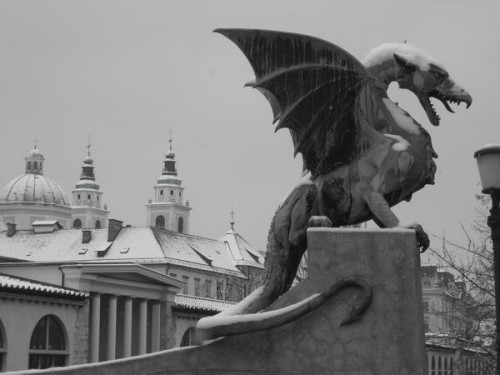 A fine deterrent to an interloper, this is also a way of lightening the load for flight. Most vultures are long-lived, and there are records of Turkey Vultures living past 60 years in captivity. They are “smart” in the way people mean it, because to some degree all vultures are social, interacting in large numbers at carrion and in migration. As for man-eating? Well, long bones in the lair could be interpreted as human by someone who only got a quick glimpse before being driven away by an enraged incubating vulture’s hot projectile carrion slush. Grimmer still, in times when battlefields and other human casualties were not always swiftly cleaned up, vultures would have made meals of human dead. As nature’s “Nettoyeurs” (remember Jean Reno in La Femme Nikita?) it isn’t uncommon even today for vultures to be blamed for deaths of livestock they didn’t cause, but were taking advantage of.
A fine deterrent to an interloper, this is also a way of lightening the load for flight. Most vultures are long-lived, and there are records of Turkey Vultures living past 60 years in captivity. They are “smart” in the way people mean it, because to some degree all vultures are social, interacting in large numbers at carrion and in migration. As for man-eating? Well, long bones in the lair could be interpreted as human by someone who only got a quick glimpse before being driven away by an enraged incubating vulture’s hot projectile carrion slush. Grimmer still, in times when battlefields and other human casualties were not always swiftly cleaned up, vultures would have made meals of human dead. As nature’s “Nettoyeurs” (remember Jean Reno in La Femme Nikita?) it isn’t uncommon even today for vultures to be blamed for deaths of livestock they didn’t cause, but were taking advantage of.
I should add that there are also dragon-type creatures in the mythology of the New World, like the cliff-dwelling, human-devouring Piasa Bird of the Mississippi valley, and of course, Black Vultures and Turkey vultures live in the U.S., not to mention California Condors which had a range of nearly the entire U.S. in the times legend would have been made. And this doesn’t even scratch the surface of New World vulture mythology; the King Vulture of Central and South America has a prominent place in the mythology of the Maya.
There’s no way to know for certain that vultures were the source of the dragon myth, but I find vultures to be the closest thing to dragons that I’ve personally experienced.
Right now most Vultures that breed in the U.S. are on their wintering grounds, in the far southern states and points farther south. Even in toasty Phoenix, we won’t see them again regularly until spring, where as in so many places like Hinckley Ohio their return is celebrated on a specific date. Here in central Arizona, it will be around the third week of March. So after that, look up in the sky and see if you can Spot the Dragon.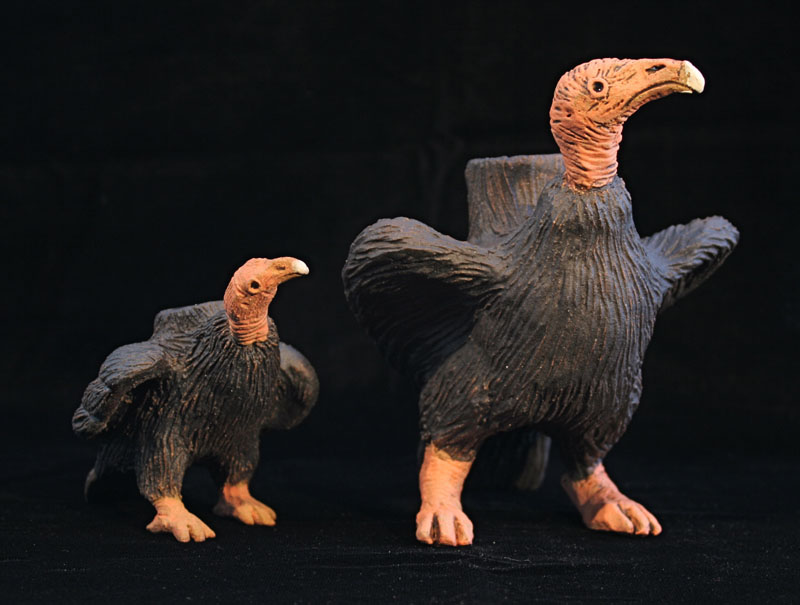
To the right are Turkey Vulture Candle-holders from Three Star Owl (inquire for pricing).
Bonus fact about turkey vultures: they have an excellent sense of smell, and I’ve heard that some Gas companies use a rotty-smelling compound called ethyl-mercaptan in their gas, to check for open-country gas leaks by looking for kettles of (frustrated!) vultures circling over broken pipeline.
Bonus bonus trivia about Lammergeier, from Wikipedia:
The Greek playwright Aeschylus was said to have been killed in 456 or 455 BC by a tortoise dropped by an eagle who mistook his bald head for a stone – if this incident did occur, the Lammergeier must be a likely candidate for the “eagle”.
The black and white photo of the very vulturine Dragon Bridge is by Barbara Meadows.